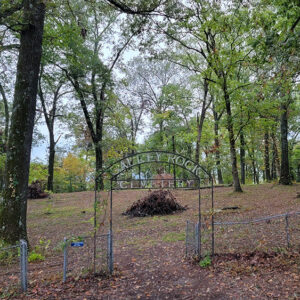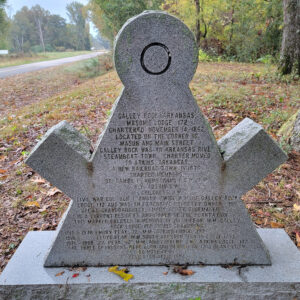calsfoundation@cals.org
Galley Rock
aka: Galla Rock (Pope County)
Galley Rock in Pope County is a two-mile shale bluff that rises almost forty feet high on the north bank of the Arkansas River, just northwest of Petit Jean Mountain. It was a natural landmark for early explorers and settlers. The area was a site for Cherokee settlers of the early 1800s and became a thriving river town in the 1830s. However, by the 1870s, the town experienced a decline, and all that remains today is the town cemetery.
During the late 1700s, river travel was the safest and most reliable mode of transportation. French explorers and trappers navigated the Arkansas River with only striking, geologic features marking the locations of their trading posts and hunting camps. Galley (or Galla) Rock was one such landmark. Although no recorded evidence exists, some historians believe the modern name Galley Rock originated from the French word “galets” (pebbles) and that the rocky outcrop may have been called Galets de Rocher by the French traders, roughly translated as “rock of pebbles.”
As the American population grew east of the Mississippi River in the early 1800s, various tribes were relocated farther to the west. A major influx of Cherokee from Tennessee and eastern Arkansas occurred around 1817. A group of Cherokee settled in the high ground upriver of Point Remove Creek; they called their settlement “The Galley,” perhaps a corruption of the French phrase “Galets de Rocher.” Under Chief John Jolly, this settlement was one of the more important locations in northwest Arkansas. Historical reports from 1819 describe the settlement as a collection of farms and constructed homes serving about one dozen families. Despite its success, the settlement lasted less than thirty years. In 1828, the western Cherokee ceded their land in Arkansas to the United States government and moved still farther west into what now is Oklahoma.
White settlers began to arrive soon after the Cherokee were gone. The rocky bluff continued its service as a river landmark—only this time for steamboats. The first recorded steamboat landing at Galley Rock was June 1835. The Little Rock (Pulaski County) newspaper, The Arkansas Times, contained a report on the passage of the steamboat Neosho, documenting its landing at Galley Rock with thirty-one sacks of salt and one barrel of whiskey.
The town of Galley Rock was established, and the 1840 Pope County census listed thirty-one families (a total of 217 people) living in Galley Rock township. Most of the residents were farmers, with just a few supporting tradesmen. Records show considerable land sales had occurred in the area by 1862. Some deeds were recorded as Galley Rock and others as Galla Rock (probably as a result of phonetic spellings), and the town was often referred to in official records by both names. Galley Rock was, at this time, a thriving river port for both Pope County and eastern Yell County, and by 1870, some accounts described the population of the township as more than 1100, with 500 living within Galley Rock itself.
However, 1869 marked the year construction began on the Little Rock and Fort Smith Railroad, and by 1872, the train served eastern Pope County and Galley Rock with a stop at Perry Station (Pope County). The river was no longer the most reliable mode of transportation. Approximately three miles east of the station, the new town of Atkins (Pope County) was established. Atkins drew both businesses and citizens from Galley Rock, and as the train surpassed the steamboat as the favored mode of transport for both people and goods, Atkins replaced Galley Rock as the area’s thriving business center. The population of Galley Rock steadily dwindled, and by 1900, the town no longer existed. A few individual homes remained for some time, but eventually all that was left was the Galley Rock Cemetery.
In 1975, the Galley Rock Historical Association was organized with the purpose of restoring the cemetery and preserving all available historical information on the area.
For additional information:
Bolton, S. Charles. Arkansas 1800–1860: Remote and Restless. Fayetteville, AR: University of Arkansas Press, 1998.
Hempstead, Fay. A Pictorial History of Arkansas. St. Louis; New York: N.D. Thompson Publishing Company, 1890.
Stroud, John C. A Heart within A Valley: A History of the Atkins Area. Atkins, AR: History Committee, Atkins Centennial Bicentennial Committee, 1976.
Holly Anderson
Little Rock, Arkansas
 Galla Creek Bridge
Galla Creek Bridge  Galley Rock Cemetery
Galley Rock Cemetery  Galley Rock Cemetery
Galley Rock Cemetery  Galley Rock Masonic Marker
Galley Rock Masonic Marker 




Comments
No comments on this entry yet.